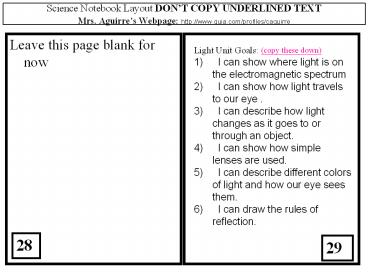Science Notebook Layout DON - PowerPoint PPT Presentation
Title:
Science Notebook Layout DON
Description:
Science Notebook Layout DON T COPY UNDERLINED TEXT Mrs. Aguirre s Webpage: http://www.quia.com/profiles/caguirre Leave this page blank for now – PowerPoint PPT presentation
Number of Views:103
Avg rating:3.0/5.0
Title: Science Notebook Layout DON
1
Science Notebook Layout DONT COPY UNDERLINED
TEXTMrs. Aguirres Webpage http//www.quia.com/p
rofiles/caguirre
- Leave this page blank for now
- Light Unit Goals (copy these down)
- I can show where light is on the
electromagnetic spectrum - I can show how light travels to our eye .
- I can describe how light changes as it goes to
or through an object. - I can show how simple lenses are used.
- I can describe different colors of light and
how our eye sees them. - I can draw the rules of reflection.
28
29
2
Science Notebook Layout DONT COPY UNDERLINED
TEXTMrs. Aguirres Webpage http//www.quia.com/p
rofiles/caguirre
Investigation 4A Light boxes Page 19 of lab
manual
1
2
3
30
31
3
Science Notebook Layout DONT COPY UNDERLINED
TEXTMrs. Aguirres Webpage http//www.quia.com/p
rofiles/caguirre
- Textbook Notes Page80-82
- Copy and complete(use 6 lines)
- Light travels in ________ _____ through
materials until it hits something. - When light hits a different material it can be
_________, _________, or ____________. - Experiment with the light boxes to see these
things happen.Draw a picture and explain
NAME Draw Define Examples from home
Absorb
Regular Reflection
Scattered reflection
Partially Absorb
Refraction (light slows down)
Refraction (light speeds up)
Light travels in straight lines Light is absorbed
Light is reflected Light is transmitted
Light through different lenses Light through different lenses
33
32
4
Science Notebook Layout DONT COPY UNDERLINED
TEXTMrs. Aguirres Webpage http//www.quia.com/p
rofiles/caguirre
- Bill Nye MovieLight
- When light hits something, it can be _______,
________, or _______. - Reflection
- Refraction
- Periscope
- Absorbing
- Waves slow down
- Infrared
- Convex
- Concave
- Optical fiber
- Greenhouse
Tape in Diffraction grating handout to this page
For each, describe or give example from the movie
34
35
5
Science Notebook Layout DONT COPY UNDERLINED
TEXTMrs. Aguirres Webpage http//www.quia.com/p
rofiles/caguirre
- How is InfraRed Different?
- List 5 things you lerned from the video on
InfraRed
The Eyes and Sight Read pages 395-400 Draw the
eye- label all nine parts Answer Q 1-4 on page
400- copy the charts!!
The Eyeball List 10 things you lerned from the
video on the Eyeball
36
37
6
Science Notebook Layout DONT COPY UNDERLINED
TEXTMrs. Aguirres Webpage http//www.quia.com/p
rofiles/caguirre
Tape in your ElectroMagnetic Spectrum Page
38
39
7
Science Notebook Layout DONT COPY UNDERLINED
TEXTMrs. Aguirres Webpage http//www.quia.com/p
rofiles/caguirre
- How a Microscope Works
- Page 84 textbook
Objective Lens and Eyepiece
Focusing Magnification
For each box, write 2 facts from each paragraph
of the reading
40
41
8
Science Notebook Layout DONT COPY UNDERLINED
TEXTMrs. Aguirres Webpage http//www.quia.com/p
rofiles/caguirre
43
42
9
Science Notebook Layout DONT COPY UNDERLINED
TEXTMrs. Aguirres Webpage http//www.quia.com/p
rofiles/caguirre
Microscope Safety Rules 1. Never engage in
horseplay around the microscopes 2. Make sure
the power cord is not hanging down in order to
minimize possibility of accidents 3. When
storing the microscope, wrap the power cord
around the base 4. Always carry the
microscope with two hands -- one holding the arm
and one supporting the base 5. Never use the
coarse adjustment knob to lower the objective
unless you are watching the stage and specimen.
Prepared Slides
Name _______ Name _______ Name _______ Mag.
____ X Mag. ____ X Mag. ____ X
45
44
10
Science Notebook Layout DONT COPY UNDERLINED
TEXTMrs. Aguirres Webpage http//www.quia.com/p
rofiles/caguirre
- Cell Theory- Page 92-94
Similarities Among Cells Page 95
1. 2
3 4
1. All cells are surrounded by a cell membrane. 2. All cells contain organelles
3. All cells contain cytoplasm. 4. All cells contain DNA.
47
46
11
Science Notebook Layout DONT COPY UNDERLINED
TEXTMrs. Aguirres Webpage http//www.quia.com/p
rofiles/caguirre
- Onion Cells Lab (Page 27-28 of lab manual)
Thinking about what you observed a. Based on your
sketches and observations, what is onion tissue
made of? b. How many individual square structures
could you see under low power? Medium power? High
power? c. How can you tell where one square
structure ends and another begins? What do each
of the individual structures you observed have in
common? d. When Robert Hooke looked at cork under
a microscope in 1663, he called each of the
square structures a cell because they reminded
him of tiny rooms. Do your observations of onion
cells agree with his? Explain why or why not. e.
Look at the diagram of a plant cell in Chapter 5
of your textbook. Which structures can you
identify in your onion cells? Label them on your
sketches.
49
48































